Bestsellers
-

Elektor Digital PIC Microcontroller Programming (E-book)
in 10 captivating lessons Using the lessons in this book you learn how to program a microcontroller. You’ll be using JAL, a free but extremely powerful programming language for PIC microcontrollers, which enjoys great popularity in the hobby world. Starting out from scratch virtually, you slowly build up the knowledge. No previous knowledge is needed: anyone can get started with this book. Assuming you have absorbed all lessons – meaning you have actually completed all the exercises – you should be confident to write PIC microcontroller programs, as well as read and understand programs written by other people. JAL commands You learn the function of JAL commands such as include, pin, delay, forever loop, while loop, case, exit loop, repeat until, if then, as well as the use of functions, procedures and timer- and port interrupts. JAL programs You make an LED blink, build a time switch, measure a potentiometer’s wiper position, produce sounds, suppress contact bounce, and control the brightness of an LED. And of course you learn to debug, meaning: how to spot and fix errors in your programs. Hardware You learn to recognize various components including the PIC microcontroller, potentiometer and quartz crystal, and how to wire up a PIC microcontroller and effectively link it to your PC. A breadboard is used for the purpose, allowing you to easily modify the component arrangement for further experimenting. The companion software with this book can be downloaded free of charge, including the JAL programming language. In addition, you may order a kit of parts so you don’t have to go shopping for the required components. Especially for a beginner, this is the easiest way to start with this unique pastime. Having finished this book does not mean you are through with your pastime. You can get your hands dirty again, and if desired use other books packed with fun projects using the JAL programming language. More information may be found at the end of the lessons in the chapter "Done! What’s next?""
€ 29,95
Leden € 23,96
-
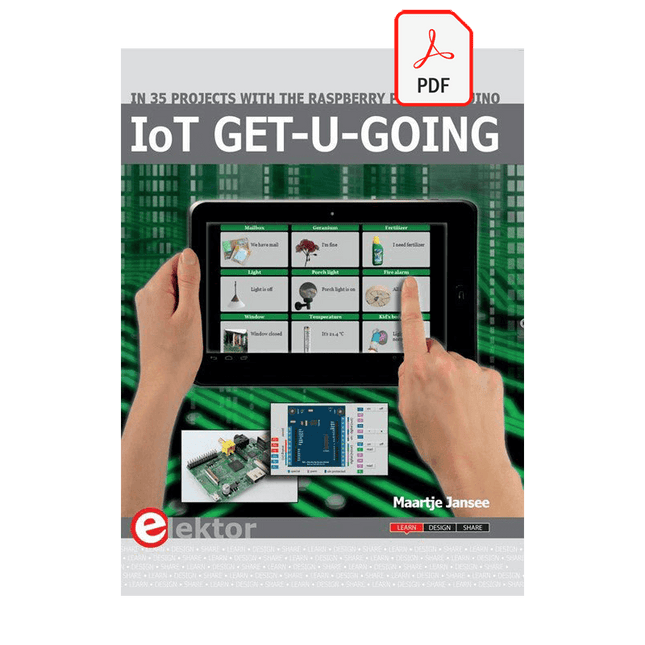
Elektor Digital IoT GET-U-GOING (E-book)
In 35 Projects with the Raspberry Pi and Arduino The Internet of Things (IoT) is a trend with a strong technological impulse. At home, we want to do everything on our tablets, from browsing Facebook to watching TV, from operating lights to keeping an eye on the temperature. In 35 fun projects, this book will show you how to build your own Internet of Things system. We'll cover the hardware (primarily the Raspberry Pi and Arduino) and the software that makes control via Internet possible. We employ Wi-Fi and radio links so no requirement any longer to install cabling crisscross through your home. Assuming the projects in the book are finished, you have a complete Internet of Things system that allows you to control and view of everything in your home. For example, if there's something in the mail box or the car is securely in the garage. Also, you can switch on the lights and the alarm from your couch. The crisp explanations allow the projects to be customized with ease, for example, to turn on your coffee machine or TV remotely. The index gives easy access to creative projects that can serve as an example, enabling you to do all the connecting to the IoT independently. All project software can be downloaded free of charge from the Elektor website. In this unique book, Raspberry Pi, Arduino and HTML webpages with stylesheets and JavaScript come together in clearly-described, easy-to-build projects. This special book is an essential part of your collection!
€ 34,95
Leden € 27,96
-

Elektor Digital Elektor Maart/April 2024 PDF (NL)
Elektor GREEN en GOLD leden kunnen deze uitgave hier downloaden. Nog geen lid? Klik hier om een lidmaatschap af te sluiten. CaptureCountobjectdetector en -teller op de Raspberry Pi 5 Spanningsreferentie met Arduino Pro Minilineariseer en kalibreer analoge ingangen FPGA’s voor beginnersvan MCU naar FPGA-programmering Update: STM32 Wireless Innovation Design Contest 2024 Bluetooth LE met MAUIbesturingsapps voor Android en co. Port Expander breakout-boardmeer I/O’s op je development board AI-specialistmachine learning met de Jetson Nano 2024: een AI-odysseeeen eerste verkenning van TensorFlow 262.144 manieren om Game of Life te spelenlezersproject in het kort Uit het leven gegrepende Chinese draak Draaien met die (DC-borstel)motor!voorbeeldprojecten uit de Elektor Motor Control Development Bundle ESP32/RS-232-adapterdraadloze verbinding voor klassieke meetinstrumenten Alle begin......gaat verder met de opamp Aanbevolen ESP-bibliotheken Piëzo-elektrische componentenvreemde onderdelen Slimme objecttellereenvoudige beeldherkenning met Edge Impulse Oplossingen voor de lastigste uitdagingen bij embedded ontwikkeling ESP32 Terminalhandheld met aanraakscherm Aan de slag met Zephyr RTOSkrachtig – maar lastig... Bekroonde ethiekeen vraaggesprek met Alexander Gerfer, CTO van Würth Elektronik eiSos, over het faciliteren van innovatie en bewust gedrag Project 2.0correcties, updates en brieven van lezers
€ 9,95
-

Elektor Digital Elektor Mei/Juni 2023 (PDF)
Elektor GREEN en GOLD leden kunnen deze uitgave hier downloaden.Nog geen lid? Klik hier om een lidmaatschap af te sluiten. Super-servotestervoor vier servo’s – stand-alone of in-system Analoge signalen en microcontrollersADC’s, DAC’s, stroommeting en meer embedded world 2023 Sub-Nyquist-sampling in de praktijkhogere frequenties betrouwbaar bemonsteren met subsampling Met Android-smartphone, spreek ik met ESP32?praktisch project met behulp van de Android WiFi-API Actief 1kHz-filter voor vervormingsmetingmeet beter door het het meetsignaal te optimaliseren Alle begin......multivibreert verder! Project 2.0correcties, updates en brieven van lezers Het nieuwe I3C-protocoleen waardig opvolger van I2C – of gebakken lucht? BlueRC: IR-afstandsbediening met smartphone en ESP32universeel en aanpasbaar Microcontroller-documentatie verklaarddeel 2: registers en blokschema’s Automatisering van testen en metentestapparatuur programmeren om je te dienen Elektor Infographicstesten en meten Overspanningsbeveiliging voor veilige werkingtransiëntbescherming voor niet-geïsoleerde DC/DC-voedingsmodules Meetapparatuur van het merk Wihatesters en meters voor installaties waar u op kunt bouwen Automatisch testen en samenwerken aan testresultaten Uit het leven gegrepenelektronica op hoog niveau Energieloggermeet en registreert het stroomverbruik Montage van de M.A.R.S. Rover Kit van 4tronix Parkeerschijf met e-papier displayinnovatief digitaal alternatief eCO2 Telegram-botmeet de luchtkwaliteit via Telegram Achter de schermen van DHZ high-end audioTon Giesberts van Elektor over de fijne kneepjes van het analoog ontwerpen Oost West Lab Bestwerk in uitvoering... RFID-tag’s lezen, en een RFID-deurslotvoorbeeldprojecten uit de Elektor Arduino Experimenteerbundel HF-stroomprobe voor oscilloscoopHF-stroommetingen gemakkelijk gemaakt Niet voor watjes – Makerfabs Robot Arm Kitmet de Raspberry Pi Pico en MicroPython Generatieve KIwie heeft dit eigenlijk gemaakt? Hexadokupuzzelen voor elektronici
€ 9,95
-
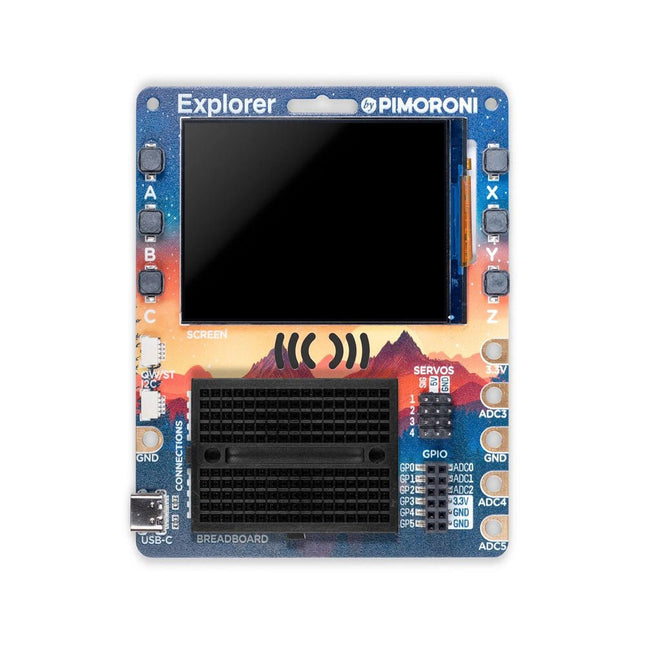
Pimoroni Pimoroni Explorer Starter Kit
De Pimoroni Explorer Starter Kit is een elektronische avonturenspeeltuin voor fysiek computergebruik, gebaseerd op de RP2350-chip. Het bevat een 2,8-inch LCD-scherm, een luidspreker, een mini-breadboard en nog veel meer. Het is ideaal voor knutselen, experimenteren en het bouwen van kleine prototypes. Kenmerken Mini-breadboard voor het aansluiten van componenten Servoheaders Analoge ingangen Ingebouwde luidspreker Veel algemene invoer/uitvoer Connectoren voor het bevestigen van krokodillensnoeren Qw/ST-connectoren voor het bevestigen van I²C-breakouts Specificaties Aangedreven door RP2350B (Dual Arm Cortex-M33 met een snelheid tot 150 MHz met 520 KB SRAM) 16 MB QSPI-flash met ondersteuning voor XiP 2,8" IPS LCD-scherm (320 x 240 pixels) Stuurprogramma-IC: ST7789V Helderheid: 250 cd/m² Actief gebied: 43,2 x 57,5 mm USB-C-connector voor programmeren en voeding Mini-broodplank Piezo-luidspreker 6x door de gebruiker bestuurbare schakelaars Reset- en opstartknoppen Gemakkelijke toegang tot GPIO-headers (6x GPIO's en 3x ADC's, plus 3,3 V voeding en aarde) 6x krokodillenklemterminals (3x ADC's, plus 3,3 V stroom en aarding) 4x 3-pins servo-uitgangen 2x Qw/ST (Qwiic/STEMMA QT)-connector 2-pins JST-PH-connector voor het toevoegen van een batterij Gleuf voor sleutelkoord! Inclusief 2x bureaustandaardvoeten Volledig gemonteerd (solderen niet nodig) Programmeerbaar met C/C++ of MicroPython Inbegrepen 1x Pimoroni Explorer 1x Multi-Sensor Stick – een fraaie nieuwe alles-in-één supersensorsuite voor omgevings-, licht- en bewegingsdetectie Selectie van verschillende gekleurde LED's om mee te knipperen (inclusief rood, geel, groen, blauw, wit en RGB) 1x Potentiometer (voor analoog amusement) 3x 12 mm schakelaars met verschillende gekleurde kapjes 2x Servo's met continue rotatie 2x 60 mm wielen voor bevestiging aan uw servo's 1x AAA-batterijhouder (batterijen niet inbegrepen) 1x klittenband om de batterijhouder aan de achterkant van de Explorer te bevestigen 20x pin-naar-pin- en 20x pin-naar-socket-jumperdraden voor het maken van verbindingen op uw breadboard 1x Qw/ST-kabel om de Multi-Sensor Stick aan te sluiten 1x Siliconen USB-C kabel Downloads GitHub Schematic
€ 79,95€ 39,95
Leden identiek
-

SparkFun SparkFun Pro Micro (RP2350)
De SparkFun RP2350 Pro Micro biedt een krachtig ontwikkelingsplatform, gebouwd rond de RP2350-microcontroller. Dit bord maakt gebruik van de bijgewerkte Pro Micro-vormfactor. Het bevat een USB-C-connector, Qwiic-connector, WS2812B adresseerbare RGB-LED, opstart- en resetknoppen, opnieuw instelbare PTC-zekering en PTH- en gekartelde soldeerpads. De RP2350 is een unieke dual-core microcontroller met twee ARM Cortex-M33-processors en twee Hazard3 RISC-V-processors, allemaal draaiend op maximaal 150 MHz! Dit betekent niet dat de RP2350 een quad-core microcontroller is. In plaats daarvan kunnen gebruikers selecteren welke twee processors tijdens het opstarten moeten worden uitgevoerd. U kunt twee processors van hetzelfde type of één van elk gebruiken. De RP2350 beschikt ook over 520 kB SRAM in tien banken, een groot aantal randapparatuur, waaronder twee UART's, twee SPI- en twee I²C-controllers, en een USB 1.1-controller voor host- en apparaatondersteuning. De Pro Micro bevat ook twee uitgebreide geheugenopties: 16 MB externe Flash en 8 MB PSRAM aangesloten op de QSPI-controller van de RP2350. De RP2350 Pro Micro werkt met C/C++ met behulp van de Pico SDK-, MicroPython- en Arduino-ontwikkelomgevingen. Kenmerken RP2350-microcontroller 8 MB PSRAM 16 MB Flash Voedingsspanning USB: 5 V RAW: 5,3 V (max.) Pro Micro Pinout 2x UART 1x SPI 10x GPIO (4 gebruikt voor UART1 en UART0) 4x analoog USB-C-connector USB 1.1 host-/apparaatondersteuning Qwiic-connector Knoppen Reset Boot LED's WS2812 Adresseerbare RGB-LED Rode voedings-LED Afmetingen: 33 x 17,8 mm Downloads Schematic Eagle Files Board Dimensions Hookup Guide RP2350 MicroPython Firmware (Beta 04) SparkFun Pico SDK Library Arduino Pico Arduino Core Datasheet (RP2350) Datasheet (APS6404L PSRAM) RP2350 Product Brief Raspberry Pi RP2350 Microcontroller Documentation Qwiic Info Page GitHub Repository
€ 24,95€ 12,50
Leden identiek
-

NXP Semiconductors NXP FRDM-MCXN947 Development Board
The FRDM-MCXN947 is a compact and versatile development board designed for rapid prototyping with MCX N94 and N54 microcontrollers. It features industry-standard headers for easy access to the MCU's I/Os, integrated open-standard serial interfaces, external flash memory, and an onboard MCU-Link debugger. Specificaties Microcontroller MCX-N947 Dual Arm Cortex-M33 cores @ 150 MHz each with optimized performance efficiency, up to 2 MB dual-bank flash with optional full ECC RAM, External flash Accelerators: Neural Processing Unit, PowerQuad, Smart DMA, etc. Memory Expansion *DNP Micro SD card socket Connectivity Ethernet Phy and connector HS USB-C connectors SPI/I²C/UART connector (PMOD/mikroBUS, DNP) WiFi connector (PMOD/mikroBUS, DNP) CAN-FD transceiver Debug On-board MCU-Link debugger with CMSIS-DAP JTAG/SWD connector Sensor P3T1755 I³C/I²C Temp Sensor, Touch Pad Expansion Options Arduino Header (with FRDM expansion rows) FRDM Header FlexIO/LCD Header SmartDMA/Camera Header Pmod *DNP mikroBUS User Interface RGB user LED, plus Reset, ISP, Wakeup buttons Inbegrepen 1x FRDM-MCXN947 Development Board 1x USB-C Cable 1x Quick Start Guide Downloads Datasheet Block diagram
€ 29,95
Leden € 26,96
-

JOY-iT JOY-iT Pi Energy Mini
Wide Range Power Supply for Raspberry Pi With the PiEnergy Mini, you can operate your Raspberry Pi with a voltage of 6 to 36 V DC. You can use the button integrated on the board to both power up and power down your Raspberry Pi. Communication with the Raspberry Pi is via GPIO4, but this connection can also be cut by removing a resistor to use the pin freely. Thanks to the ultra-flat design, it can also be used in many housings. The pin header is included and not soldered on to keep the design even flatter. Specifications Input voltage 6 to 36 V DC Output voltage 5.1 V Output current Up to 3 A (active ventilation recommended for additionally connected loads) Cable cross-section at the power input 0.2-0.75 mm² Interface to the Raspberry Pi GPIO4 Microcontroller ATtiny5 Further connections 5 V fan connector (2-pin/2.54 mm)Solder pads for external on/off switch Compatible with Raspberry Pi 3, 4, 5 Dimensions 23 x 56 x 11 mm Included Board with mounted heat sink Pin header (2x5) Spacer, screw, nut Downloads Datasheet Manual
€ 19,95€ 9,95
Leden identiek
-
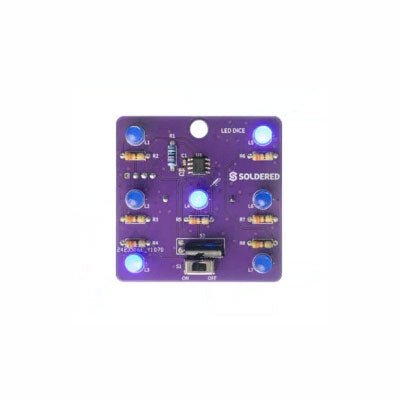
Soldered LED Dice Solder Kit
If you are looking for an easy way to get started with soldering or simply want to make a small portable gadget, this set is a great opportunity. "LED cube" is an educational set for learning the soldering skill, with which you get a small electronic game at the end. After you turn on and shake this board, certain leds will light up randomly and symbolize the number, as if a real die had been thrown. It is based on the Attiny404 microcontroller, programmed in Arduino, and there is a battery on the back which makes this gadget portable. There is also a keychain so you can always carry your new game with you! Soldering is easy according to the markings on the board. Included 1x PCB 1x ATtiny404 microcontroller 7x LEDs 7x Resistors (330 ohm) 1x Resistor (10 kohm) 1x Battery holder 1x CR2032 battery 1x Switch 1x Vibration sensor SW-18020P 1x Keychain ring
€ 9,95
Leden € 8,96
-
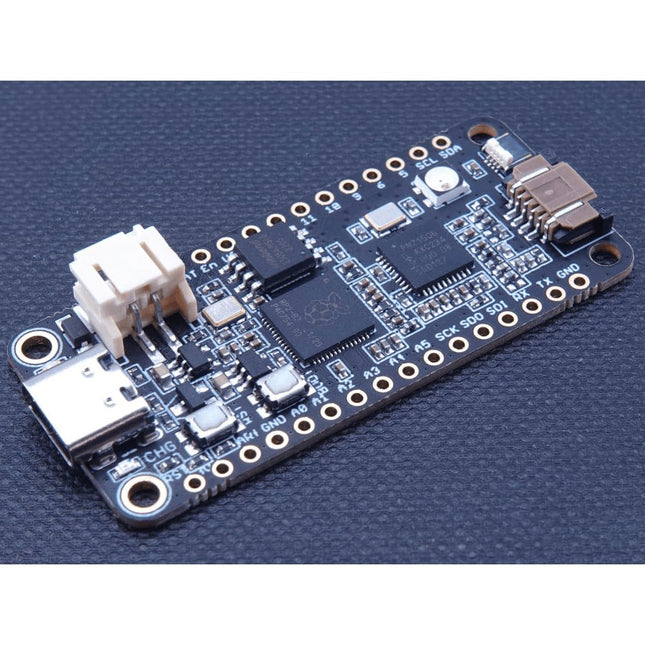
iLabs iLabs Challenger RP2040 NFC
The Challenger RP2040 NFC is a small embedded computer, equipped with an advanced on-board NFC controller (NXP PN7150), in the popular Adafruit Feather form factor. It is based on an RP2040 microcontroller chip from the Raspberry Pi Foundation which is a dual-core Cortex-M0 that can run on a clock up to 133 MHz. NFC The PN7150 is a full featured NFC controller solution with integrated firmware and NCI interface designed for contactless communication at 13.56 MHz. It is fully compatible with NFC forum requirements and is greatly designed based on learnings from previous NXP NFC device generation. It is the ideal solution for rapidly integrating NFC technology in any application, especially small embedded systems reducing Bill of Material (BOM). The integrated design with full NFC forum compliancy gives the user all the following features: Embedded NFC firmware providing all NFC protocols as pre-integrated feature. Direct connection to the main host or microcontroller, by I²C-bus physical and NCI protocol. Ultra-low power consumption in polling loop mode. Highly efficient integrated power management unit (PMU) allowing direct supply from a battery. Specifications Microcontroller RP2040 from Raspberry Pi (133 MHz dual-core Cortex-M0) SPI One SPI channels configured I²C Two I²C channel configured (dedicated I²C for the PN7150) UART One UART channel configured Analog inputs 4 analog input channels NFC module PN7150 from NXP Flash memory 8 MB, 133 MHz SRAM memory 264 KB (divided into 6 banks) USB 2.0 controller Up to 12 MBit/s full speed (integrated USB 1.1 PHY) JST Battery connector 2.0 mm pitch On board LiPo charger 450 mA standard charge current Dimensions 51 x 23 x 3,2 mm Weight 9 g Note: Antenna is not included. Downloads Datasheet Quick start example
€ 22,95€ 11,50
Leden identiek
-

Seeed Studio Seeed Studio CAN-BUS Shield V2 adopts MCP2515 en MCP2551
Features Volgt CAN V2.0B tot 1 Mb/s Industriële standaard 9 pins sub-D connector OBD-II en CAN standaard pinout selecteerbaar. Verwisselbare chip select pin Verwisselbare CS pin voor TF-kaartslot Verwisselbare INT pin Schroef terminal die gemakkelijk aan te sluiten CAN_H en CAN_L Arduino Uno pin headers Micro SD kaarthouder 2 Grove connectoren (I2C en UART) SPI-interface tot 10 MHz Standaard (11 bit) en uitgebreide (29 bit) data en remote frames Twee ontvangstbuffers met geprioriteerde berichtopslag
€ 32,95€ 16,50
Leden identiek
-

Pi Modules DiP-Pi Pico WiFi Master for Raspberry Pi Pico
The DiP-Pi WiFi Master is an Advanced WiFi connectivity System with sensors embedded interfaces that cover most of possible needs for IoT application based on Raspberry Pi Pico. It is powered directly from the Raspberry Pi Pico VBUS. The DiP-Pi WiFi Master contains Raspberry Pi Pico embedded RESET button as also ON/OFF Slide Switch that is acting on Raspberry Pi Pico Power Sources.The DiP-Pi WiFi Master is equipped with WiFi ESP8266 Clone module with embedded antenna. This feature open a wide range of IoT applications based on it.In Addition to all above features DiP-Pi WiFi Master is equipped with embedded 1-wire, DHT11/22 sensors, and micro–SD Card interfaces. Combination of the extended powering, battery, and sensors interfaces make the DiP-Pi WiFi Master ideal for IoT applications like data logger, plants monitoring, refrigerators monitoring etc.DiP-Pi WiFi Master is supported with plenty of ready to use examples written in Micro Python or C/C++.SpecificationsGeneral Dimensions 21 x 51 mm Raspberry Pi Pico pinout compatible Independent Informative LEDs (VBUS, VSYS, V3V3) Raspberry Pi Pico RESET Button ON/OFF Slide Switch acting on Raspberry Pi Pico Powering Source Embedded 3.3 V @ 600 mA LDO ESP8266 Clone WiFi Connectivity ESP8266 Firmware Upload Switch Embedded 1-wire Interface Embedded DHT-11/22 Interface Powering OptionsRaspberry Pi Pico micro-USB (via VBUS)Embedded Peripherals and Interfaces Embedded 1-wire interface Embedded DHT-11/22 Interface Micro SD Card Socket Programmer Interface Standard Raspberry Pi Pico C/C++ Standard Raspberry Pi Pico Micro Python Case CompatibilityDiP-Pi Plexi-Cut CaseInformative LEDs VB (VUSB) VS (VSYS) V3 (V3V3) System Protection Direct Raspberry Pi Pico Hardware Reset Button PPTC 500 mA @ 18 V fuse on EPR EPR/LDO Over Temperature protection EPR/LDO Over Current protection System Design Designed and Simulated with PDA Analyzer with one of the most advanced CAD/CAM Tools – Altium Designer Industrial Originated PCB Construction 2 ozcopper PCB manufactured for proper high current supply and cooling 6 mils track/6 mils gap technology 2 layers PCB PCB Surface Finishing – Immersion Gold Multi-layer Copper Thermal Pipes for increased System Thermal Response and better passive cooling Downloads Datasheet Manual
€ 19,95€ 9,95
Leden identiek
-

Pimoroni Pimoroni Raspberry Pi Pico Breakout Garden Base
Pico Breakout Garden Base sits underneath your Pico and lets you connect up to six of our extensive selection of Pimoroni breakouts to it. Whether it's environmental sensors so you can keep track of the temperature and humidity in your office, a whole host of little screens for important notifications and readouts, and, of course, LEDs. Scroll down for a list of breakouts that are currently compatible with our C++/MicroPython libraries!As well as a labelled landing area for your Pico, there's also a full set of broken out Pico connections, in case you need to attach even more sensors, wires, and circuitry. We've thrown in some rubber feet to keep the base nice and stable and to stop it from scratching your desk, or there are M2.5 mounting holes at the corners so that you can bolt it onto a solid surface if you prefer.The six sturdy black slots are edge connectors that connect the breakouts to the pins on your Pico. There's two slots for SPI breakouts, and four slots for I²C breakouts. Because I²C is a bus, you can use multiple I²C devices at the same time, providing they don't have the same I²C address (we've made sure that all of our breakouts have different addresses, and we print them on the back of the breakouts so they're easy to find).As well as being a handy way to add functionality to your Pico, Breakout Garden is also very useful for prototyping projects without the need for complicated wiring, soldering, or breadboards, and you can grow or change up your setup at any time.Features Six sturdy edge-connector slots for breakouts 4x I²C slots (5 pins) 2x SPI slot (7 pins) Landing area with female headers for Raspberry Pi Pico 0.1” pitch, 5 or 7 pin connectors Broken-out pins Reverse polarity protection (built into breakouts) 99% assembled – just need to stick on the feet! Compatible with Raspberry Pi Pico
€ 17,95
Leden € 16,16
-

Elektor September/Oktober 2025 (NL)
Elektor GREEN en GOLD leden kunnen deze uitgave hier downloaden. Nog geen lid? Klik hier om een lidmaatschap af te sluiten. ESP32 Audio Transceiver Board (Deel 2)Draadloze audio-overdracht Inductieve AM-zenderGebruikt Pico's PIO in een Arduino-sketch Navigeren door draadloze protocollen navigerenEen technische gids Satelliettracking met behulp van LoRaHet TinyGS-netwerk brengt gegevens uit de ruimte naar de aarde. 4G-Compatibele SMS afstandsbedieningBedien je apparatuur op afstand Hogesnelheids-probeIngangen met hoge impedantie voor signalen tot 200 MHz Uit het leven gegrepenKafka KrakenSDR Prestatietests met de RP2350Is een upgrade van Raspberry Pi Pico 1 naar versie 2 de moeite waard? Contactloze E-veldmetingen (2)Een laservibrometer voor het beoordelen van de trillingen van het membraan Kristallen en oscillatorenVerbetering van de kristalnauwkeurigheid door gerichte keuze van condensatoren Alle begin......gaat audio! Zelf firmware coderen voor embedded projecten SPECTRAN® V6 MobileModulaire, configureerbare realtime-spectrumanalyzer voor betrouwbare metingen over alle frequentiebereiken De toekomst van AI wordt gesmeed in siliciumEen interview met Anastasiia Nosova Autonome Sensor-Node v2.0 (Systeemarchitectuur)Zonne-energieplatform met geïntegreerde GPS, LoRaWAN en meer Precieze positioneringBluetooth channel sounding getest Testgestuurd ontwikkelen bij het schrijven van firmware Telefoon gestuurde modelautoWi-Fi + ESP32 + Smartphone = Afstandsbediening 2025: Een AI-odysseeAI-redeneermodellen: De gedachtegang-revolutie Zonne-laadregelaar met MPP-tracking (3)Software en Inbedrijfstelling Raspberry Pi Zero Web Streaming CameraDe ZeroTier VPN gebruiken Beste soldeerder van de Beneluxvakmanschap in de schijnwerpers Seminaroverzicht Electronics & ApplicationsLeer, ontdek en netwerk op E&A 2025 Eurocircuits at E&A 2025 E&A gadget 2025: racen over de beursvloer met slimme printplaat op wielenVijf vragen aan Casper van Doorne, ontwerper van de beursgadget Beursgadget E&A bekendontwerp en bestuur je eigen raceauto Vakbeurs E&A is het elektronicaparadijs van de Benelux“Techneuten blijven kinderen” Rohde & SchwarzPioneering Innovation in Test & Measurement Diederik Jekel opent Electronics & Applications
€ 15,95
-

Elektor Digital Elektor Juli/Augustus 2025 (PDF) NL
Elektor GREEN en GOLD leden kunnen deze uitgave hier downloaden. Nog geen lid? Klik hier om een lidmaatschap af te sluiten. OBD2-sensordashboardOude meters vormden het startpunt van een zoektocht naar echte gegevens OBD2: voeg een toerenteller en schakelindicator toe aan je autoRetro, maar uiterst nuttig LiDAR- en Visiesensoren voor Robotica Sensor+Test 2025 en PCIM 2025 Contactloze E-Veldmetingen (1)Een Trillende Membraan voor het Detecteren van Gelijkspanningen of Statische Elektrische Velden Draadloze brievenbusmeldervan optische sensoren tot radar: enkele mogelijkheden Elektor Mini-Wheelieeen zelfbalancerende robot ZonnecellenVreemde onderdelen, de serie Aan de slag met een moderne radarsensorStaat een nauwkeurige meting op uw radar? Uit het leven gegrepenpapierfabriek CybersecurityZware tijden voor hackers Infographics: IoT en sensoren 2025 Bluetooth 6.0 brengt verbeterde toepassingen voor afstandsbepalingNieuwe versie biedt betere apparaatpositionerings- en -locatieservices Draadloze communicatie verkennen met BeagleY-AI Err-lectronicsCorrecties, updates en lezerspost Alle begin......sluit het thema opamps af Een krachtige AI-codeerassistentsneller ontwikkelen met Continue en Visual Studio Code Zonne-laadregelaar met MPPT (2)Het schema Ultrasone obstakeldetectoreen eenvoudig project om slechtzienden te helpen 2025: Een AI-odysseeHalfjaaroverzicht Raspberry Pi Standalone MIDI-synthesizer (3)Het slimmer maken en een gebruikersinterface toevoegen Meshtastic: een demonstratieprojectEen slim netwerk van LoRa-radio's Analoge audio-frequentiegeneratorHoogwaardige sinusgenerator met instelbare frequentie
€ 9,95
-

Elektor Digital Raspberry Pi 3 – Basic to Advanced Projects (E-book)
This book is about the Raspberry Pi 3 computer and its use in various control and monitoring applications. The book explains in simple terms and with tested and working example projects, how to configure the Raspberry Pi 3 computer, how to install and use the Linux operating system, and how to write hardware based applications programs using the Python programming language. The nice feature of this book is that it covers many Raspberry Pi 3 based hardware projects using the latest hardware modules such as the Sense HAT, Swiss Pi, MotoPi, Camera module, and many other state of the art analog and digital sensors. An important feature of the Raspberry Pi 3 is that it contains on-board Bluetooth and Wi-Fi modules. Example projects are given in the book on using the Wi-Fi and the Bluetooth modules to show how real-data can be sent to the Cloud using the Wi-Fi module, and also how to communicate with an Android based mobile phone using the Bluetooth module. The book is ideal for self-study, and is intended for electronic/electrical engineering students, practising engineers, research students, and for hobbyists. It is recommended that the book should be followed in the given Chapter order. Over 30 projects are given in the book. All the projects in the book are based on the Python programming language and they have been fully tested. Full program listings of every project are given in the book with comments and full descriptions. Experienced programmers should find it easy to modify and update the programs to suit their needs. The following sub-headings are given for each project to make it as easy as possible for the readers to follow the projects: Project title Description Aim of the project Raspberry Pi type Block diagram Circuit diagram Program listing
€ 29,95
Leden € 23,96
-

Elektor Digital Elektor Juli/Augustus 2024 (PDF)
Elektor GREEN en GOLD leden kunnen deze uitgave hier downloaden. Nog geen lid? Klik hier om een lidmaatschap af te sluiten. Kleine warmtebeeldcameraeen op Arduino UNO gebaseerde DHZ-oplossing Project-update #3: ESP32-gebaseerde energiemeterintegratie en test met Home Assistant 2024: een AI-odysseeobjectdetectie verbeteren met verfijnde technieken De Raspberry Pi gaat AInieuwe kit bevat M.2 HAT+ met AI-versneller Sensoren voor weerstationswat is de beste keuze? Lees uw analoge watermeter uit met AI (1)koppel uw oude watermeter met het IoT! GSM-alarmdraadloze garagebeveiliging Low-power Thread-devices geoptimaliseerd en onder de loep genomenweinig vermogen... weinig inspanning? Uit het leven gegrepende genderkloof Zelfbouw-nevelkamermaak onzichtbare straling zichtbaar SparkFun Thing Plus Mattereen veelzijdig Matter-gebaseerd IoT development board IoT-retrofittenRS232-apparaten klaarstomen voor Industry 4.0 Stimuleer het IoT met 8-bit MCU’s Technologie stimuleert duurzaamheidvooruitgang leidt in veel toepassingen tot efficiënter energiegebruik AWS voor Arduino en co. (1)AWS IoT ExpressLink in de praktijk Luchtstroomdetector met alleen een Arduinozonder externe sensoren! Lekdetectorverbonden met de Arduino-cloud Kristallenvreemde onderdelen Universele logger voor de tuinAI-tuinieren komt een stapje dichterbij Analoge 1kHz-generatorsinussen met geringe vervorming Miletus: webapps offline gebruikeninclusief toegang tot het systeem en het apparaat! Van 4G naar 5Gis het echt zo eenvoudig? Alle begin......gaat symmetrisch
€ 9,95
-

Elektor Digital Elektor September/Oktober 2022 (PDF)
electronica fast forward Start- & Scale-Up Awards les préparatifs vont de plus en plus vite ! Bluetooth Low Energy avec ESP32-C3 et ESP32 il n'est pas toujours nécessaire que ce soit le WiFi ! Renifleur Bluetooth LE pirater un dongle USB Makerdiary nRF52840 MDK Cube LED RVB magique concevoir du matériel autour d'un RP2040 Marche/arrêt automatique pour le compresseur de pâte à souder Productions vidéo Elektor livestreams, webinaires et cours pour ingénieurs et pro-makers Électrifiez votre vélo avec un kit de conversion vélo électrique Tous les débuts... ...multiplie les tensions Tiré de la vie activités annexes Teensy 4.0 – pourquoi cette planche est-elle si rapide ? la vitesse n'est pas de la sorcellerie ! Simulation d'un amplificateur de puissance audio avec TINA essayez d'abord, puis construisez Développez et gérez vos propres nœuds LoRaWAN IoT exemple de chapitre : modules Dragino LHT65, LDS01 et LDS02 LoRaWAN Projet 2.0 corrections, mises à jour et lettres des lecteurs 5G – juste pour moi contrôle total sur les déploiements 5G avec son propre réseau cellulaire Infographie Elektor Conseils pour développer une interface WiFi équiper les applications avec des interfaces WiFi Horloge de tour du Rhin Mk 2 Analyseur de spectre audio avec dékatrons nouvelle vie pour les tubes vintage Envoyer des données à Telegram avec un ESP32 et quelques pièces Un filtre coupe-bande Fliege pour les mesures audio mesure mieux avec un filtre coupe-bande Changer les communications industrielles Ethernet à paire unique – bien plus qu'un simple nouveau connecteur PUT-ter mâle électronique voici comment fonctionne le transistor unijonction programmable Écran tactile rond pour Raspberry Pi HyperPixel 2.1 rond de Pimoroni Télédétection avec détection de perte de connexion avec modules nRF24L01+ Récepteur FM numérique avec Arduino et TEA5767 régler avec un Arduino Nano Convertir l'interface OLED de SPI en I²C Meilleur laboratoire Est-Ouest un passe-temps ne prend pas sa retraite... Dix ans d'éthique en électronique Tessel Renzenbrink à propos de la société numérique et bien plus encore Hexadoku Le Sudok électorisé original
€ 9,95
-

Elektor Digital Elektor Juli/Augustus 2022 (PDF)
Testeur audio pas cher avec un logiciel basé sur PC et une interface audio USB Fréquencemètre de courant alternatif surveille la fréquence et la tension du secteur Un petit compteur à induction solution abordable pour l'établi Flottant sur les ondes sonores un examen plus approfondi du kit de lévitation acoustique Makerfabs Tous les débuts... ...va rectifier FFWD : j’ai encore hâte ! Premiers pas avec votre oscilloscope voici comment utiliser les boutons et les interrupteurs Un MSF-SDR avec le Raspberry Pi Pico décoder le signal horaire avec un Pi Pico-SDR Capteurs d'humidité du sol pour systèmes d'irrigation arrosage automatique Troubles sur le marché des équipements de test et de mesure les petits acteurs innovent Infographie Elektor L'inspiration, c'est de ça qu'il s'agit Entretien avec l'entrepreneur Walter Arkesteijn, InnoFaith Beauty Sciences Minimiser les interférences CEM des bobines de stockage Création d'interfaces graphiques avec Python : Morpion Jeroen et Jan continuent d'être pionniers Compteur ESR analogique simple avec précision de compteur à bobine mobile Feu tricolore Sigfox CO2 sans réseau WiFi ! Les femmes dans la technologie « Tout est une question de mérite jusqu'à ce que le mérite ait des seins » Oscilloscope pour tablette à petit budget ADS1013D rapport qualité/prix ? Anatomie des prises intelligentes Lesquels sont adaptés aux hackers ? Impédance cutanée et capacité cutanée étudié expérimentalement Tiré de la vie Rien de bon dans notre propre pays J'ai consulté le Pokit Meter un couteau suisse parmi les instruments de mesure Hexadoku Des puzzles pour les ingénieurs en électronique
€ 9,95
-

Elektor Digital Elektor Januari/Februari 2021 (PDF)
ZELFBOUW LIPO- SUPERCHARGER-BUNDELLiPo-lader, -booster en -beveiliging van GreatScott en Elektor MTHECAM – DE MINI-THERMOCAMERAeenvoudige warmtebeeldcamera voor het lokaliseren van hot- en coldspots REVIEW: WELLER-SOLDEERSTATION WE 1010 ELECTRONICA FAST FORWARD 2020 – DE WINNAARS I2S TESTSIGNAALGENERATOR MET AVR-MICROCONTROLLER32-bit 1-kHz digitale sinus, fs 192 kHz, niveau instelbaar van 0 tot –110 dB DOMOTICA MET DE RASPBERRY PIRPi luistert op 433,92 MHz SCHAKELINGEN ONLINE SIMULEREN UIT HET LEVEN GEGREPENde dunne grens tussen orde en chaos ALLE BEGIN......hoeft niet zo moeilijk te zijn OOST WEST LAB BESTeen blik in het allerheiligste, waar interessante projecten worden geboren VERBIND UW THERMOSTAAT MET ESPHOMEeen poging om domotica op de juiste manier te doen DEVELOPER’S ZONEtips & trucs, vakkunstigheden en andere nuttige informatie WIE HET KLEINE NIET EERTuit de ideeënbus van Elektor RASPBERRY PI FULL STACKRPi en RF24 als hart van een sensornetwerk MULTITASKING MET DE ESP32 (6)event groups MEERKANAALS POWER ANALYZERtot 3 kanalen, met grafisch en alfanumeriek display ANALOGE ELEKTRONICA ONTWERPENcase-study #2 – deel 3: passieve filters REVIEW: DRAADLOZE MEETMODULE JOY-IT VAX-1030 NIEUWE LCR-METER 50 HZ – 2 MHZ (DEEL 2)bediening, kalibratie en programmeren van de firmware ERROR ANALYSIStips en trucs: spanningsregelaars, PCB-ontwerp en meer HET OPEN HARDWARE OBSERVATORYcommunitygebaseerde beoordeling van open source-hardware JAVA OP DE RASPBERRY PIeen vraaggesprek met Frank Delporte DATA-ANALYSE EN KUNSTMATIGE INTELLIGENTIE IN PYTHONechte gegevens interpreteren met NumPy, pandas en scikit-learn INTERACTIEFcorrecties & updates || brieven van lezers ONZE COMMUNITY IN CIJFERS KENNISMAKING MET DE PARALLAX PROPELLER 2 (DEEL 1)inleiding HEXADOKU
€ 9,95
-
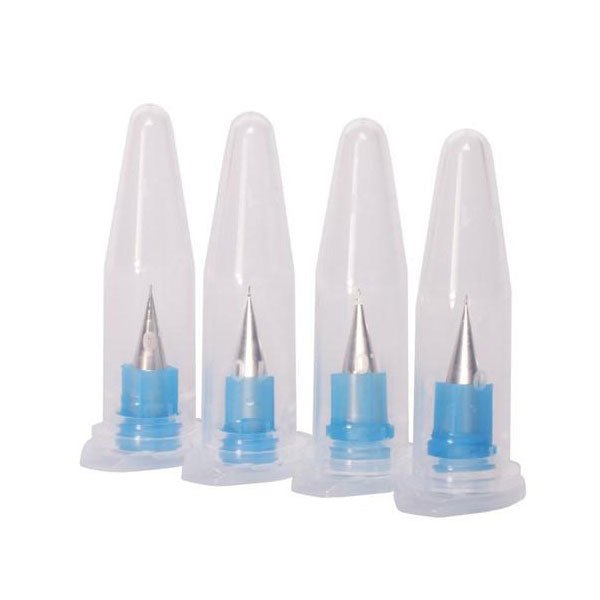
Voltera Voltera sproeiers (150 micron)
If you want to push the resolution limits of the V-One, these dispensing tips will help enable your experimental projects. This pack contains 4 extra fine nozzles with an internal diameter of 0.150 mm (6 mil). Do not use with solder paste! It will clog!
€ 84,95€ 42,50
Leden identiek
-
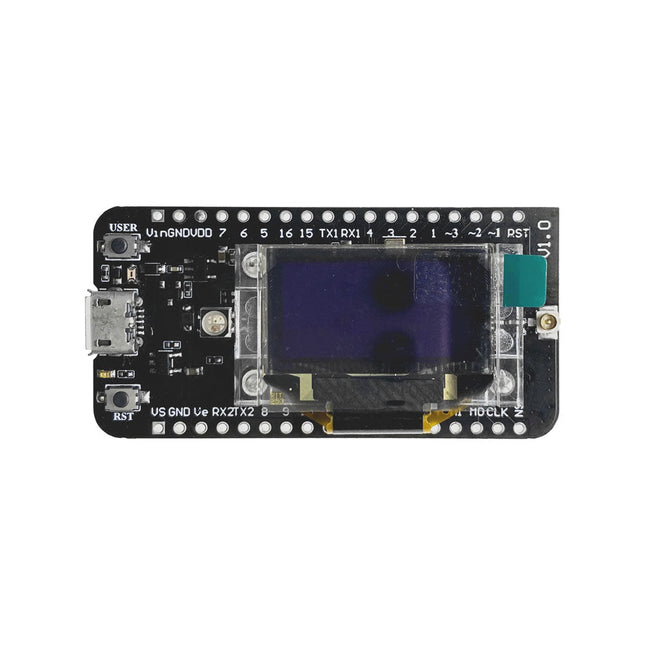
Heltec Automation CubeCell HTCC-AB02S LoRa Development Board with GPS (EU868)
The CubeCell series is designed primarily for LoRa/LoRaWAN node applications. Built on the ASR605x platform (ASR6501, ASR6502), these chips integrate the PSoC 4000 series MCU (ARM Cortex-M0+ Core) with the SX1262 module. The CubeCell series offers seamless Arduino compatibility, stable LoRaWAN protocol operation, and straightforward connectivity with lithium batteries and solar panels. The HTCC-AB02S is a developer-friendly board with an integrated AIR530Z GPS module, ideal for quickly testing and validating communication solutions. Features Arduino compatible Based on ASR605x (ASR6501, ASR6502), those chips are already integrated the PSoC 4000 series MCU (ARM Cortex M0+ Core) and SX1262 LoRaWAN 1.0.2 support Ultra low power design, 21 uA in deep sleep Onboard SH1.25-2 battery interface, integrated lithium battery management system (charge and discharge management, overcharge protection, battery power detection, USB/battery power automatic switching) Good impendence matching and long communication distance Onboard solar energy management system, can directly connect with a 5.5~7 V solar panel Micro USB interface with complete ESD protection, short circuit protection, RF shielding, and other protection measures Integrated CP2102 USB to serial port chip, convenient for program downloading, debugging information printing Onboard 0.96-inch 128x64 dot matrix OLED display, which can be used to display debugging information, battery power, and other information Using Air530 GPS module with GPS/Beidou Dual-mode position system support Specifications Main Chip ASR6502 (48 MHz ARM Cortex-M0+ MCU) LoRa Chipset SX1262 Frequency 863~870 MHz Max. TX Power 22 ±1 dBm Max. Receiving Sensitivity −135 dBm Hardware Resource 2x UART1x SPI2x I²C1x SWD3x 12-bit ADC input8-channel DMA engine16x GPIO Memory 128 Kb FLASH16 Kb SRAM Power consumption Deep sleep 21 uA Interfaces 1x Micro USB1x LoRa Antenna (IPEX)2x (15x 2.54 Pin header) + 3x (2x 2.54 Pin header) Battery 3.7 V lithium battery (power supply and charging) Solar Energy VS pin can be connected to 5.5~7 V solar panel USB to Serial Chip CP2102 Display 0.96" OLED (128 x 64) Operating temperature −20~70°C Dimensions 55.9 x 27.9 x 9.5 mm Included 1x CubeCell HTCC-AB02S Development Board 1x Antenna 1x 2x SH1.25 battery connector Downloads Datasheet Schematic GPS module (Manual) Quick start GitHub
€ 49,95€ 24,95
Leden identiek
-

Seeed Studio Seeed Studio Grove I²C Thermocouple Amplifier (MCP9600)
Features Integrated Cold-Junction Compensation Supported Types (designated by NIST ITS-90): Type K, J, T, N, S, E, B and R Four Programmable Temperature Alert Outputs: Monitor Hot- or Cold-Junction Temperatures Detect rising or falling temperatures Up to 255°C of Programmable Hysteresis Programmable Digital Filter for Temperature Low Power Dimensions: 20 mm x 40 mm x 18 mm Weight: 18 g Application Petrochemical Thermal Management Hand-Held Measurement Equipment Industrial Equipment Thermal Management Ovens Industrial Engine Thermal Monitor Temperature Detection Racks Downloads Eagle Files Github library Datasheet
€ 22,95
Leden € 20,66
-
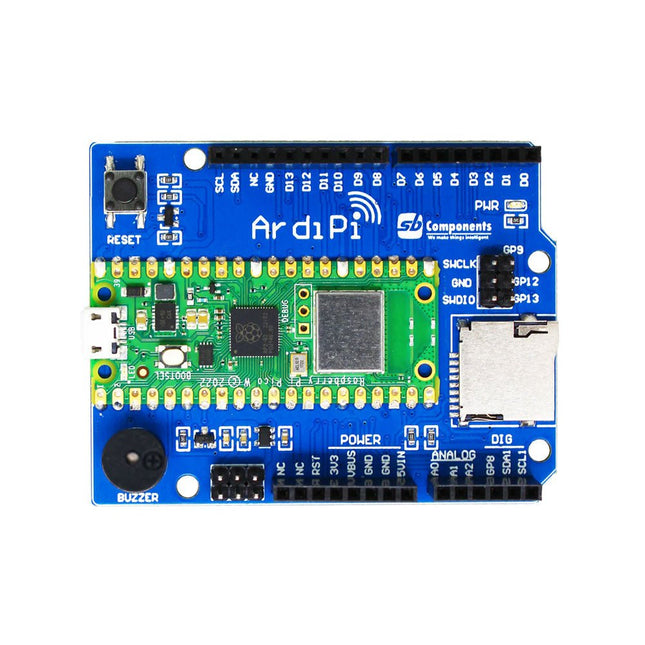
SB Components ArdiPi Uno R3 Board (based on Raspberry Pi Pico W)
ArdiPi is the ultimate Arduino Uno alternative packed with powerful specs and exciting features in the Arduino Uno form factor. You can enjoy a low-cost solution with access to the largest support communities for Raspberry Pi. ArdiPi variant is powered by Raspberry Pi Pico W. The built-in Wi-Fi and Bluetooth connectivity makes the board ideal for IoT projects or projects requiring wireless communication. Features Arduino Uno form factor, so you can connect 3.3 V compatible Arduino shields SD card slot for storage and data transfer Drag-and-drop programming using mass storage over USB Multifunction GPIO breakout supporting general I/O, UART, I²C, SPI, ADC & PWM functions. Multi-tune Buzzer to add audio alert into the project SWD pins breakout for serial debugging Multi-platform support like Arduino IDE, MicroPython, and CircuitPython. Comes with HID support, so the device can simulate a mouse or keyboard Specifications Powered by RP2040 microcontroller which is a dual-core Arm Cortex-M0+ processor, 2 MB of onboard flash storage, 264 kB of RAM On-board single-band 2.4 GHz wireless interfaces (802.11n) for WiFi and Bluetooth 5 (LE) WPA3 & Soft access point supporting up to four clients Operating voltage of pins 3.3 V and board supply 5 V 25 Multipurpose GPIOs breakout in Arduino style for easy peripheral interfacing I²C, SPI, and UART communications protocol support 2 MB of onboard Flash memory Cross-platform development and multiple programming language support
€ 24,95
Leden € 22,46























